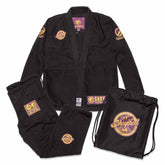Height in BJJ: Pros and Cons of Being Tall vs. Short
Introduction
Brazilian Jiu-Jitsu (BJJ) is a martial art celebrated for its technique, leverage, and adaptability. Height often comes up in discussions of physical advantage or disadvantage. Is being tall an edge or a liability? What about being shorter? In this article, we dive deep into the real-world experience behind height in BJJ, drawing on expert insight. The goal is to offer you clarity, practical tips, and a sense of authority you can trust. Whether you are a tall athlete or a compact dynamo, this guide is for you.
1- Why Height Matters in BJJ
Height influences how you interact with space, leverage, and movement. Long limbs create reach and framing advantages. Short limbs bring compact leverage and center-of-gravity control. Neither height is inherently better. Each comes with unique dynamics. The real power lies in using your natural frame to your advantage. Experts across gyms agree: success in BJJ is not about being tall or short. It is about how well you move, think, and adapt.
2- The Tall Grappler: Strengths & Challenges
Strengths
- Extended Reach: Your limbs let you control distance. You can grip far and manipulate the opponent before they can react.
- Effective Framing: Long arms and legs excel at creating structure. You can keep opponents at bay with frames in sweeps or defensive positions.
- Sweeps and Trip Threats: Tall athletes often catch opponents off-balance using oversized posture or trip setups. It is easier to off-roll or tripod.
- Guard Play Variety: From spider guard to lasso to butterfly, the tall grappler’s legs can entangle and isolate effectively.
Challenges
- Base Vulnerabilities: Taller individuals often come with a higher centre of gravity. That can make staying balanced harder when under pressure.
- Smaller Opponent Manoeuvring: Shorter grapplers can squeeze in tighter, threatening underhooks and hip control that exploit your frame.
- Compact Exploits: Smaller practitioners may find creative angles, like low underhooks or knee slides, that bypass your longer frame.
Pro Tips for Tall Athletes
- Train Balance and Lowering Base: Practice low stances and strong postural control. Regularly drill posture breaks and coiling movements for resilient positioning.
- Frame Smart: Use your reach consciously. Do not overextend. Slip your longer limbs inside control zones but retract carefully to avoid exposure.
- Distance Management: Learn to control the range. Stay just outside your opponent’s effective zone. Use reach to set up sweeps without getting overwhelmed.
- Leg Entanglements: Hone spider, de la Riva, lasso, and deep half. Those positions maximize your length while keeping a safe barrier.
- Drill Against Size-Down Grapplers: Partner with shorter, pressure-heavy teammates. Learn how they try to crawl under your frame. Build counters and hip isolation drills.
Shop BJJ Uniform For Tall Guys
3- The Short Grappler: Strengths & Challenges
Strengths
- Low Base & Stability: Your compact frame puts your center of gravity close to the ground. You are harder to sweep or roll.
- Tight Entries: Shorter athletes can worm inside guards and locks. They find underhooks or half-guard entries that taller opponents often leave exposed.
- Power Leverage: Short limbs can apply force closer to joints. Power tends to concentrate. Classic examples: arm locks, tight kimuras, and control positions.
- Compact Guard Threats: Techniques like butterfly, single leg-X, x-guard or deep half fit your frame. You can manipulate the opponent base in tight, efficient ways.
Challenges
- Limited Reach: You may struggle to secure grips, especially pant grips or far sleeve grabs. Passing long-legged guards can be tricky.
- Fighting Distance: Taller opponents can establish frames or grips before you get close. Closing the gap needs precision and timing.
- Guard Flexibility: Getting into a spider or lasso guard requires flexibility and precise footwork. You might need extra mobility training.
Pro Tips for Short Athletes
- Master Closing Distance: Use sawing, collar posture breaks, and inside angles. Snapping in with timing helps bypass their knee or foot positions.
- Hug the Hips: Smash posture, collar control, over-under setups. Stick close. Compress their frame. Let friction work for you.
- Leverage Your Power: Embed your base and shift from your hips. You do not need long levers. Your strength lies in compact structure and torque.
- Exploit Underhooks: Against taller opponents, controlling one or both underhooks neutralizes reach. It destabilizes their frames.
- Flexible Guard Work: Invert, hip-bump, or use short-base options like deep half or single X. These maximize tight control without needing sprawling limbs.
Shop BJJ uniform for small guys
4- Short vs Tall Grappler for BJJ
Here is a Short vs Tall Grappler Comparison Chart for BJJ:
| Aspect | Tall Grappler | Short Grappler |
|---|---|---|
| Reach & Distance Control | Excellent – longer arms/legs allow controlling grips and space from farther away. | Limited – must close the distance quickly to be effective. |
| Guard Play | Strong long-range guards (spider, lasso, de la Riva, worm guard). | Strong close-range guards (closed guard, half guard, butterfly). |
| Frames & Defense | Strong frames due to limb length; harder to smash guard at range. | Compact defense; harder to isolate limbs for submissions. |
| Sweeps | Leverage-based sweeps from distance, tripod sweeps, long hook sweeps. | Powerful base-breaking sweeps from close contact (scissor, hip bump). |
| Submissions | Easier to lock triangles, omoplatas, and long-arm chokes. | Tighter armbars, guillotines, and body locks due to compact structure. |
| Takedowns | Effective for trips and long-range foot sweeps; challenges in low double-legs. | Lower stance makes double-legs and body locks more effective. |
| Base & Balance | Higher center of gravity, more vulnerable to being off-balanced. | Lower center of gravity, harder to sweep or topple. |
| Mobility in Tight Spaces | Can be limited in scrambles or when opponents get chest-to-chest. | Excellent in scrambles; can maneuver through small gaps. |
| Opponent Exploits | Vulnerable to low attacks, leg locks, and underhooks. | Vulnerable to long-range guards and being kept at a distance. |
5- Tactics & Strategy: Height-Smart Game Plans
Drilling for Your Frame
- Tall grapplers: Drill extended guard entries, seated passing, and frame-based sweeps. Emphasize posture and balance.
- Short grapplers: Drill compact guard retention, hip smashes, turtle attacks, and tight over-under control.
Positional Adjustments
- Taller: Stay at angles. Do not let opponents flatten or climb your sides easily.
- Shorter: Hug the hips. Use underhooks to neutralize reach or long frames.
Mindset & Adaptability
- Every athlete should cultivate flexibility, mentally and physically.
- Recognize when your body type does not fit the standard mold. Then adapt.
- Train with multiple partners. Experience diverse frames.
- Build empathy, learn variations, and augment your strengths.
6- Training Habits That Transcend Height
Universal Strength & Mobility Tips:
- Hip Mobility: essential for both tall and short bodies.
- Core Control: builds stability, prevents sweeps, assists transitions.
- Grip Strength: strong hands aid both reach reliance and tight control.
- Positional Drilling: isolate passing or guard retention. Drill slowly and in detail.
- Physics Awareness: understand lever arms, center of gravity, weight distribution, not just instinct.
Positional Sparring & Awareness
- Set up drills focusing on specific frames.
- Experiment with altering posture, base height, and grip entry.
- Try both "being the tall" and "being the short" in training.
- Sharpen your ability to sense how different frames respond.
Drilling with Diverse Body Types
- Regularly roll with athletes of different heights. Share feedback.
- Tall partners may show mobility challenges.
- Short ones reveal compression and coil strength.
- Learn common patterns and counters from each.
7- Conclusion: Thrive at Your Height
Height in BJJ is neither a blessing nor a curse. It is simply a frame. What matters is how you move within it. How do you train to exploit it? Tall athletes must manage balance, frame control, and range. Short athletes must master compact entanglement, tight entries, and leverage.
But at the end of the day, the best grapplers of any height train smart. They develop awareness. They adapt the strategy. They cultivate mobility, control, timing, and mind-set. Your height is your canvas; paint your game with precision, creativity, and intent.


















